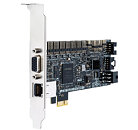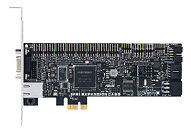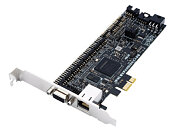- Joined
- Oct 9, 2007
- Messages
- 47,670 (7.43/day)
- Location
- Dublin, Ireland
| System Name | RBMK-1000 |
|---|---|
| Processor | AMD Ryzen 7 5700G |
| Motherboard | Gigabyte B550 AORUS Elite V2 |
| Cooling | DeepCool Gammax L240 V2 |
| Memory | 2x 16GB DDR4-3200 |
| Video Card(s) | Galax RTX 4070 Ti EX |
| Storage | Samsung 990 1TB |
| Display(s) | BenQ 1440p 60 Hz 27-inch |
| Case | Corsair Carbide 100R |
| Audio Device(s) | ASUS SupremeFX S1220A |
| Power Supply | Cooler Master MWE Gold 650W |
| Mouse | ASUS ROG Strix Impact |
| Keyboard | Gamdias Hermes E2 |
| Software | Windows 11 Pro |
ASUS this week rolled out the IPMI Expansion Card, an add-on card that lends your PC or workstation remote-management capabilities on par with servers or HPC units in a data-center. The half-height add-on card is essentially an ASPEED AST2600A3-GP multi-function remote-management chip on a stick. On the I/O side, it puts out a 1 GbE remote-management network interface, and a VGA connector for some very basic display.
It connects to your machine over a PCI-Express 3.0 x1 host interface, along a BMC, PM-bus, and SPI headers. and relies on a 6-pin PCIe power connector for its power needs. Quite a few of ASUS's workstation-class motherboards feature these headers. It also puts out eight 4-pin PWM fan headers. The card lets you perform remote management, including remote BMC firmware updates, over a web-browser based control panel. The company didn't reveal pricing or availability information.



View at TechPowerUp Main Site
It connects to your machine over a PCI-Express 3.0 x1 host interface, along a BMC, PM-bus, and SPI headers. and relies on a 6-pin PCIe power connector for its power needs. Quite a few of ASUS's workstation-class motherboards feature these headers. It also puts out eight 4-pin PWM fan headers. The card lets you perform remote management, including remote BMC firmware updates, over a web-browser based control panel. The company didn't reveal pricing or availability information.



View at TechPowerUp Main Site






